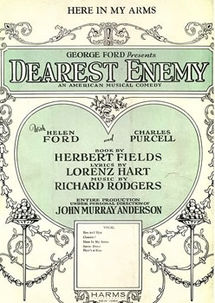- Dearest Enemy
-
Dearest Enemy 
Sheet music cover (cropped)Music Richard Rodgers Lyrics Lorenz Hart Book Herbert Fields Basis A true American Revolutionary War incident Productions 1925 Broadway Dearest Enemy is a musical with a book by Herbert Fields, lyrics by Lorenz Hart, and music by Richard Rodgers. This was the first of eight book musicals written by the songwriting team of Rodgers and Hart and writer Herbert Field. [1] The musical takes place in 1776, during the American Revolutionary War.
Contents
Production and background
Herbert Fields, Rodgers and Hart first took their musical to Herbert's father, Lew Fields, to produce, but he declined, thinking the Revolutionary War story would not be commercial. Ultimately George Ford, husband of Helen Ford, the star of the show, agreed to produce it. The musical had been variously described as an operetta and a genuine comic opera in the press.[2]
The Broadway production opened on September 18, 1925 at the Knickerbocker Theatre, and closed on May 22, 1926, after 286 performances. Directed by John Murray Anderson, the cast included Flavia Arcaro as Mary, Helen Spring as Jane, John Seymour as Harry, Helen Ford as Betsy, Charles Purcell as Sir John, and H. E. Eldridge as Washington.
A television musical special featuring Cyril Ritchard, Anne Jeffreys, Robert Sterling, and Cornelia Otis Skinner as Mrs. Murray was broadcast on November 26, 1955.[3]A cast recording of that broadcast was released on compact disc in 1997.
Plot
Based on a true American Revolutionary War incident, its heroine is Mary Lindley Murray who, under orders from General Washington, detained British troops by serving them cake and wine in her Kips Bay, Manhattan home long enough for some 4,000 American soldiers to reassemble in Washington Heights in September 1776. Reality gives way to fanciful fictionalization with the addition of a pair of love stories, one involving Mary's daughter Jane and British General Tyron's son Harry, the other focusing on the on-again, off-again relationship between Mary's Irish niece Betsy Burke and British Capt. Sir John Copeland. Also playing a role in the plot is a houseful of beautiful young ladies eager to engage the enemy in more than just conversation, and a group of handsome young men happy to forget their patriotic duty for refreshments, music, and flirtations at the Murray mansion.
Songs
- Act I
- Heigh-Ho, Lackaday!
- War is War
- I Beg Your Pardon
- Cheerio
- Full Blown Roses
- The Hermits
- Here in My Arms
- Tho' We've No Authentic Reason
- Act II
- Gavotte
- I'd Like To Hide It
- Where the Hudson River Flows
- Bye and Bye
- Old Enough to Love
- Sweet Peter
- Here's a Kiss
- Act III
- Here in My Arms (Reprise)
Critical response
There was a "well-sustained attempt" to match the music to the plot and period. The ballads were "dainty, charming pieces."[2]
The Telegram reviewer wrote that "We have a glimmering notion that someday they will form the American counterpart of the once great triumvirate of Bolton, Wodehouse, and Kern."[2]
References
- ^ Green, Kay. Broadway musicals, show by show (1996, Edition:5), Hal Leonard Corporation, ISBN 0-7935-7750-0, p. 48
- ^ a b c Green, Stanley. The world of musical comedy (1984), Da Capo Press, ISBN 0-306-80207-4, pp 116-117
- ^ Listing imdb.com, accessed April 8, 2009
External links
- Dearest Enemy at IBDB
- Overview of show, lorenzhart.org
- Dearest Enemy plot and production information, Guide To Musical Theatre
Categories:- 1925 musicals
- Broadway musicals
- Musicals inspired by real-life events
- Musicals by Rodgers and Hart
- 1776 in fiction
Wikimedia Foundation. 2010.
